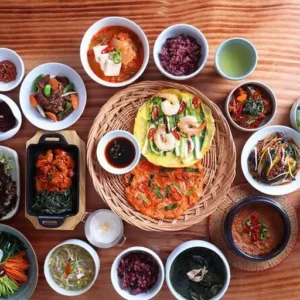Every year, Japan hosts a wide variety of eccentric and visually stunning festivals that draw thousands of curious visitors. Among the most unconventional and spectacular is the Saidaiji Hadaka Matsuri, often referred to as the “Naked Festival”—a massive event that takes place in Okayama Prefecture.
While Japan is globally recognized as a leading economic powerhouse, it is also renowned for its deep-rooted cultural heritage and one-of-a-kind celebrations. The Saidaiji Hadaka Festival is one of the country’s most extraordinary, with a history stretching back over five centuries.
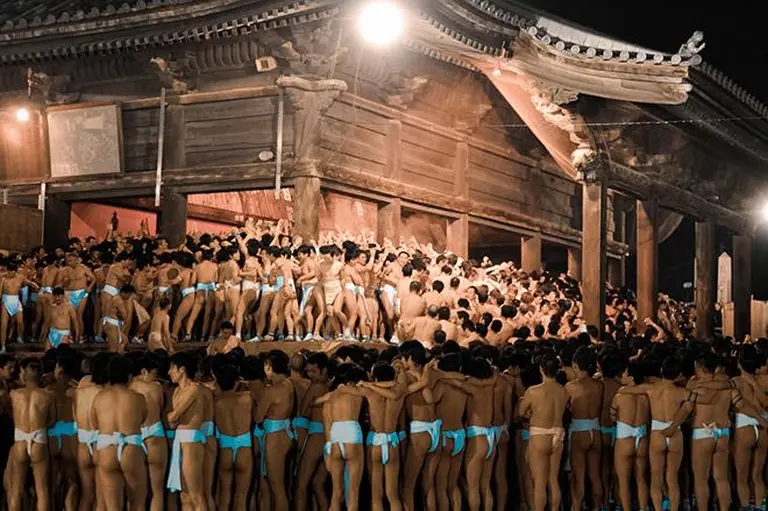
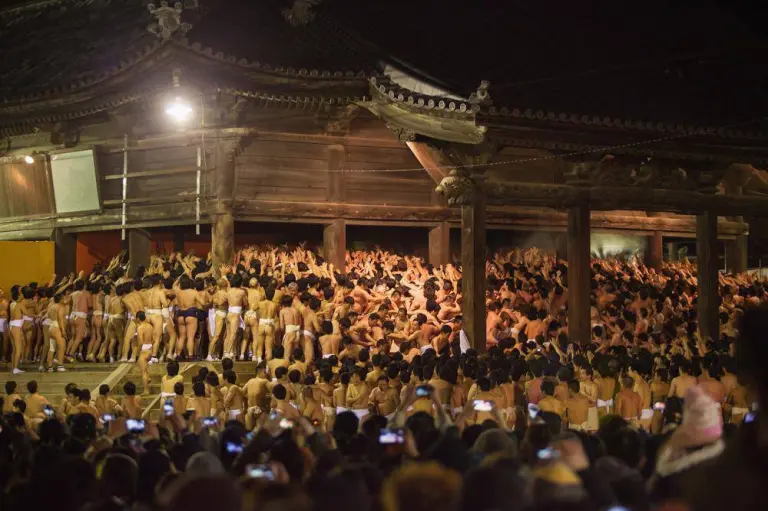
>> The Yonaguni Underwater Pyramid: Mystery of Japan’s Submerged Monument
A Chilly Ritual with Fiery Spirit
Held annually on the last Saturday of February, this festival unfolds in the cold transition between winter and spring, with temperatures often hovering around 10°C (and sometimes even lower with snow). Despite the chill, the festival’s electrifying energy keeps the atmosphere warm.
The event takes place at Saidaiji Temple, located in Okayama City, and is considered one of Japan’s most unusual and visually dramatic traditions. The origins of the Hadaka Festival date back over 500 years. Initially, worshippers would gather at the temple gates and scramble to catch sacred paper charms thrown by a high-ranking priest. But due to the fragile nature of paper, the charms were eventually replaced by a 20-centimeter wooden stick known as the shingi—now the festival’s most coveted object.
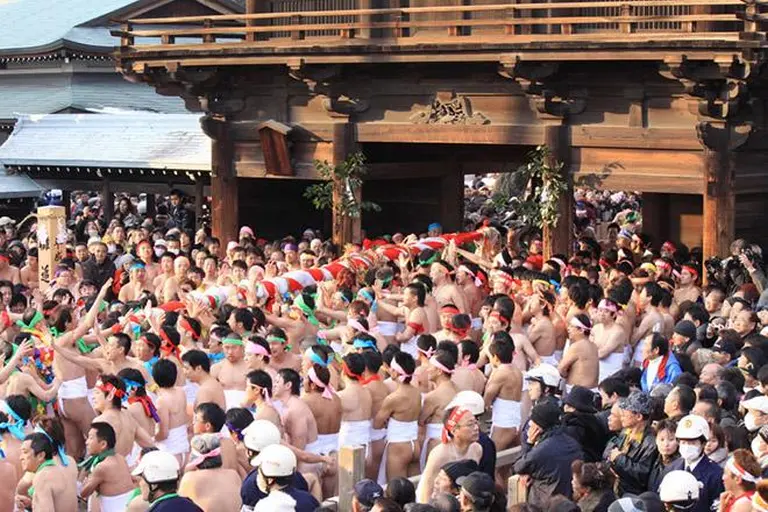
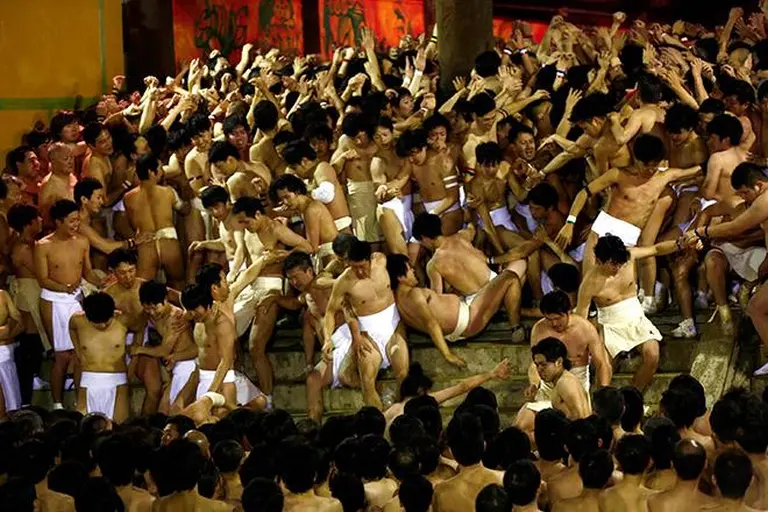
>> Battleship island: The strange legacy and dark history of Hashima, Japan
A Spiritual Test of Strength and Endurance
The main event kicks off after a children’s version of the festival, where young boys compete for rice cakes rather than the shingi. At 3:30 PM, the main ritual begins.
Male participants, clad only in fundoshi (a traditional white cotton loincloth), enter the temple grounds, while women dressed in white garments perform taiko drum routines and purify themselves in freezing water. For safety, each participant tucks a slip of paper into their fundoshi with personal contact details, in case of injury or emergency during the chaotic scramble.
As the sun sets, fireworks light up the sky between 7:00 and 7:30 PM, followed by a sacred procession to the holy stream near Saidaiji Temple. The men chant “Wasshoi! Wasshoi!” as they march and circle the temple in unison.
Every year, approximately 9,000 men take part, creating a sea of energy and anticipation. All eyes turn to the priests as they prepare to release the sacred shingi, which they do exactly at 10:00 PM. At that moment, the lights across the area are turned off—except those at the temple—and the battle begins.
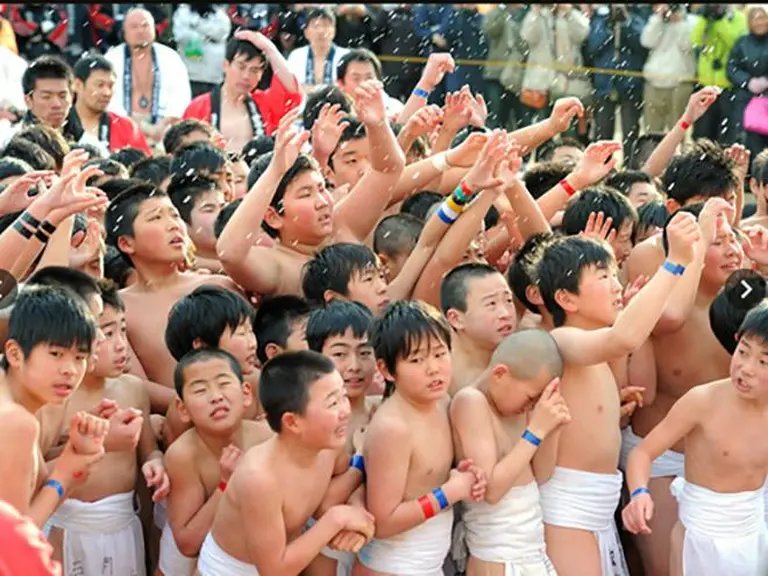
>> Aogashima: The unique Island with a “Volcano within a Volcano”
The Wild Dash for Divine Fortune
Once the shingi is tossed into the darkened temple, the real spectacle unfolds. Thousands of men plunge forward in a frenzy to seize the wooden talisman. The goal? To hold onto the shingi and place it into a special wooden box filled with rice, known as the masu. Whoever succeeds is believed to receive a full year of good fortune.
The festival concludes with one final round of good luck: priests throw 100 sacred willow branches into the crowd. Catching one is said to bring blessings just as powerful as capturing the shingi.
As the event winds down, participants and spectators alike leave Saidaiji Temple not just with adrenaline-fueled memories, but with hopeful hearts, wishing for peace, luck, and prosperity in the year ahead.
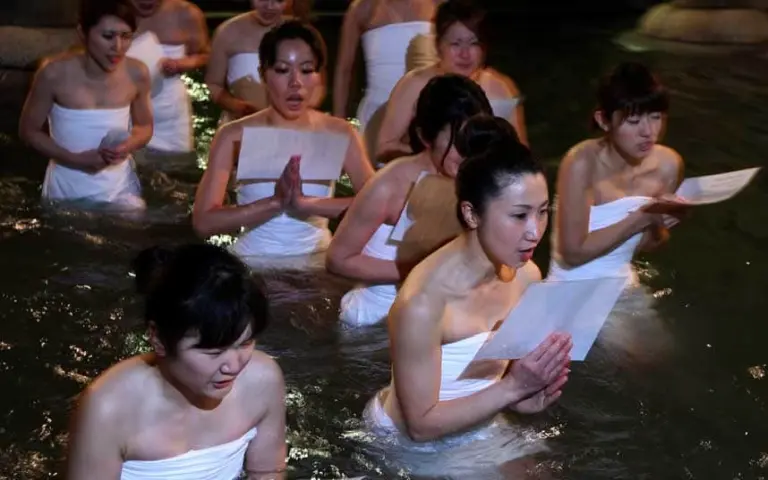
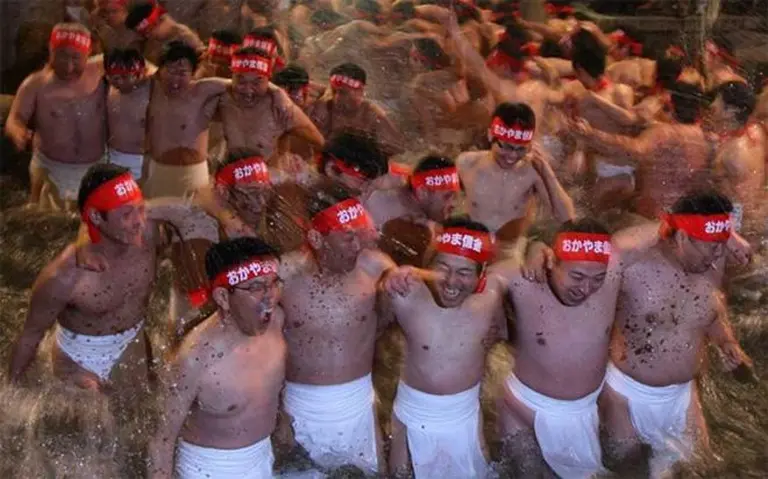
>> Spellbound by the Picture-Perfect beauty of Japan’s bamboo grove
Experiencing Japan’s Wildest Festival Firsthand
Witnessing the Saidaiji Hadaka Festival was one of the most surreal and unforgettable travel experiences of my life. It’s not just a festival—it’s a raw, primal celebration of courage, endurance, and community spirit wrapped in centuries of tradition.
What struck me the most was not the spectacle of thousands of nearly-nude men wrestling for a wooden talisman in freezing temperatures, but the intense energy and unity shared among participants. Despite the chaos, there was a deep sense of reverence for the ritual. Locals and visitors alike weren’t just there for fun—they came seeking blessings, good fortune, and a spiritual reset.
Standing among the cheering crowd, watching the fireworks explode above Saidaiji Temple, I felt a rare connection between the past and present—between a foreign tradition and my own sense of adventure. It reminded me that some of the most powerful travel moments are the ones that jolt you out of your comfort zone.
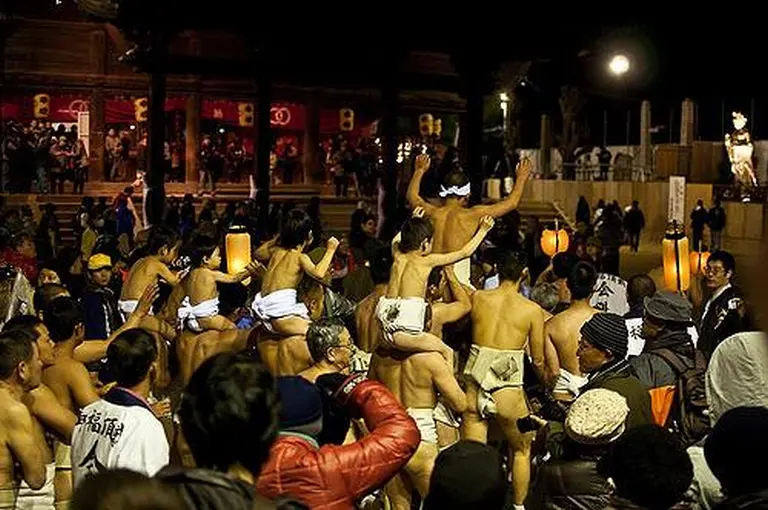
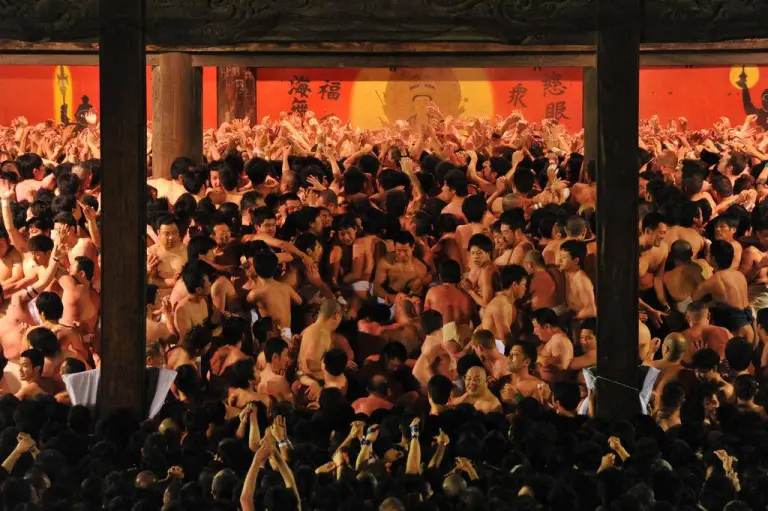
>> Amazake – The ancient Japanese superdrink making a modern comeback
Travel Tips for Visiting Saidaiji Hadaka Festival
When to Go:
The festival is held annually on the last Saturday of February. Be sure to check the exact date each year, as accommodations around Okayama get booked quickly.
Where It Happens:
Saidaiji Kannon-in Temple, Okayama City, Okayama Prefecture, Japan.
It’s easily accessible by train—just a 20-minute ride from Okayama Station to Saidaiji Station.
What to Prepare:
- Dress warmly! While the participants are nearly naked, you’ll be standing in winter temperatures, often below 10°C.
- Bring a camera, but respect the privacy and boundaries of the participants.
- Be ready for large crowds—arrive early to get a good viewing spot.
- If you want to participate (yes, foreign men are allowed), you must register in advance and follow all guidelines. Be aware that it’s physically intense and not without risk.
- There are no entrance fees, but donations to the temple are welcomed.
What Else to Do in Okayama:
- Visit Okayama Castle and Korakuen Garden, one of Japan’s top three traditional gardens.
- Try the local specialty: Barazushi (a colorful seafood rice dish).
- Explore nearby Kurashiki, a historic canal town with preserved Edo-period architecture.
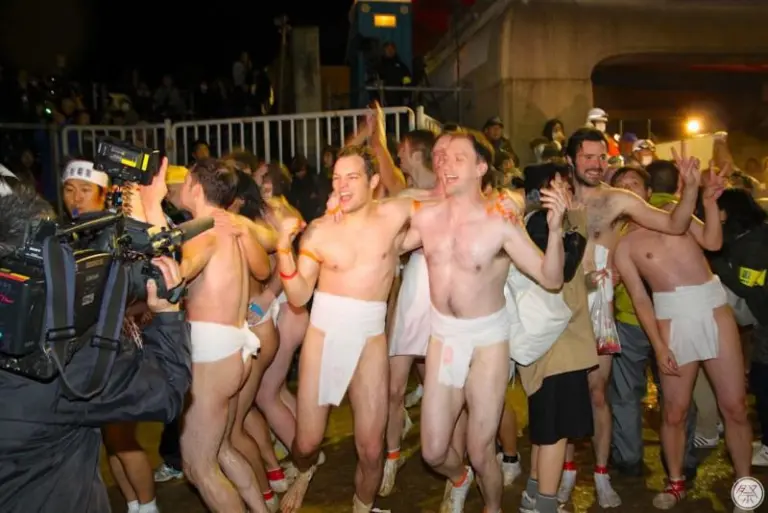
>> The 3,000-year-old sacred tree at Takeo Shrine, Japan
FAQ
What is the “Naked Festival” in Japan?
The “Naked Festival,” officially known as Hadaka Matsuri, is a traditional Japanese event where thousands of male participants wear nothing but fundoshi (a traditional white loincloth) and sometimes a short happi coat. Despite the nickname, they are not completely naked. The event is held in several regions of Japan, with the most famous version taking place in Okayama.
Where and when does Hadaka Matsuri take place?
The most renowned Hadaka Matsuri occurs at Saidaiji Temple in Okayama, typically on the third Saturday of February each year. However, variations of the festival can also be found in other prefectures, such as Konomiya in Aichi and Fukui Prefecture.
What happens during the festival?
The highlight of the event is when a Shinto priest throws two sacred sticks (shingi) into a crowd of nearly 10,000 men packed tightly in the temple grounds. These men then wrestle, push, and scramble to grab the sticks and secure good fortune for the year. It’s a chaotic, high-energy event that resembles a spiritual rugby scrum.
Why do participants wear so little?
The near-naked attire is symbolic. In Shinto tradition, purity and the shedding of material possessions are key concepts. Wearing only a fundoshi represents a form of purification and humility. Cold weather is seen as part of the cleansing process — both physical and spiritual.
Is it dangerous?
Yes, it can be. The competition to grab the sacred shingi is intense and physically demanding. Injuries are not uncommon due to the sheer number of participants, the pushing crowds, and the cold temperatures. However, safety measures have improved over the years, and organizers do their best to protect participants.
Who can participate?
In general, any adult male can participate, including foreigners. You typically need to register in advance, rent or buy the appropriate attire, and attend orientation sessions. Participants are expected to follow cultural protocols and show respect for the religious nature of the event.
What is the religious or cultural significance?
Hadaka Matsuri is rooted in Shinto beliefs about purification, fortune, and community bonding. The festival originally began over 500 years ago as a ceremony to drive away evil spirits and bring prosperity. Over time, it evolved into a large-scale event symbolizing cleansing of body and soul.
What do spectators do?
Spectators usually gather around the temple grounds or along the procession route. They cheer, take photos, and enjoy traditional food stalls. Some choose to arrive early to secure a good viewing spot, especially near the temple entrance where the main event unfolds.
Are women allowed to participate?
Traditionally, only men take part in the main event. However, women often participate in supporting roles, and some regions have created female versions of the festival or events that allow women to take part in less physically intense rituals.
Is it a family-friendly event?
Despite the name, Hadaka Matsuri is not vulgar or inappropriate. It’s considered a serious religious ritual, and families often attend to watch and support their community. That said, due to the crowds and physical intensity, parents with small children may prefer to watch from a distance.
How can I experience the festival as a tourist?
- Visit Okayama in February, and plan your trip around the third Saturday.
- Book accommodations early, as the city gets very busy during festival week.
- Dress warmly if you’re spectating — winter nights in Okayama are cold.
- Respect the cultural and religious significance of the event when photographing or filming.
Is there more to do in Okayama besides the festival?
Absolutely! While in Okayama, visitors can explore:
- Okayama Castle – A striking black castle known as “Crow Castle”
- Korakuen Garden – One of Japan’s Three Great Gardens
- Kibitsu Shrine – A historical shrine with ties to Japanese legend
- Local cuisine – Try bara-zushi or kibidango (millet dumplings)
Why should I care about the Naked Festival? Hadaka Matsuri isn’t just a quirky spectacle — it’s a vivid expression of community unity, spiritual devotion, and historical continuity. Whether you join in or simply observe, the energy is infectious, the tradition is inspiring, and the experience is truly one-of-a-kind.
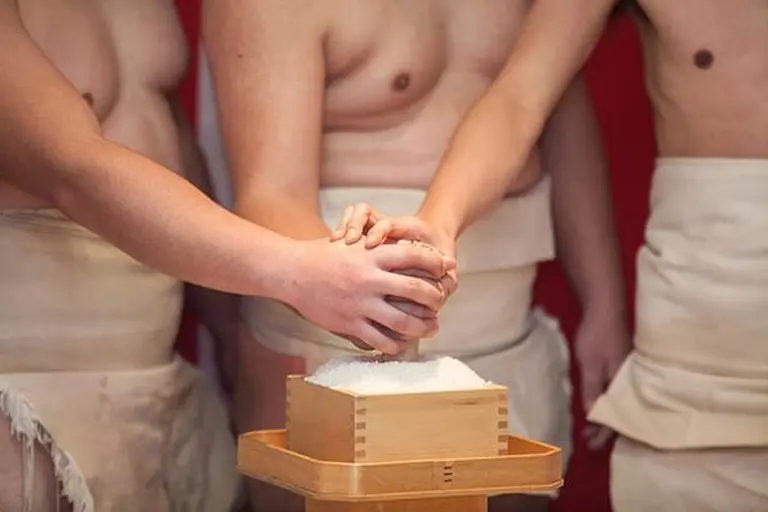
>> Masuda Rock Ship: A Millennia-Old Mystery Hidden in Japan’s Hills
Whether you’re a culture enthusiast, a spiritual seeker, or simply a curious traveler, the Saidaiji Hadaka Festival offers a rare glimpse into Japan’s living heritage. It’s chaotic, sacred, and surprisingly moving. If you’re lucky enough to be in Japan during February, don’t miss your chance to witness (or even join!) one of the boldest and most unique festivals in the world.




